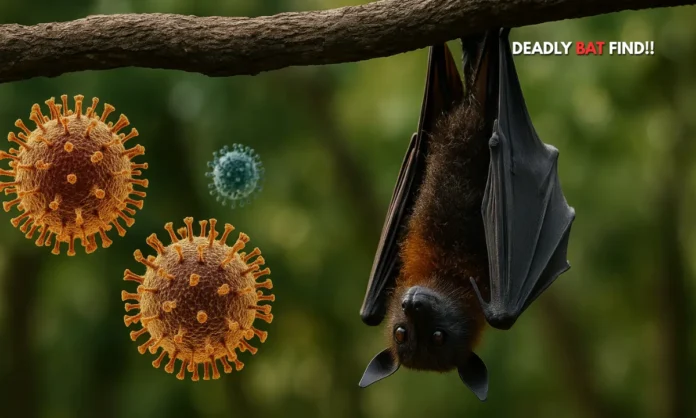Summary
- Scientists discovered 20 previously unknown viruses in bats from China’s Yunnan province, including two closely related to deadly Nipah and Hendra viruses.
- The new henipaviruses were found in fruit bats near agricultural villages, where the risk of transmission to humans or livestock is significantly higher.
- Researchers warn that increased human-wildlife contact driven by climate change and urbanisation may accelerate the emergence of such zoonotic threats.
Zoonotic Red Flag in China’s Fruit Belt
In a startling scientific breakthrough that carries deeply unsettling implications for global public health, researchers in China’s Yunnan province have uncovered 20 previously unknown viruses in bats, two of which are closely related to Nipah and Hendra — notorious henipaviruses with fatality rates reaching 75%. Published in PLOS Pathogens, the study signals a dangerous gap in our knowledge about pathogens carried by wildlife, particularly in regions where ecological boundaries between humans and animals are rapidly dissolving.
The research, conducted jointly by scientists from China and the University of Sydney, focused on 142 bat kidneys collected over four years. Rather than the usual fecal samples, the team examined kidney tissue to identify how viruses might be shed in urine — an overlooked but plausible transmission pathway. What they found was not just quantity, but alarming proximity: fruit bats hosting these viruses were caught near orchards close to rural villages. This creates a direct risk of spillover via contaminated produce, surfaces, or through livestock.
At a time when the world is still recovering from COVID-19 and reckoning with the human cost of ecological disruption, the Yunnan bat virus discovery 2025 serves as a sobering reminder. According to experts, the newly found henipaviruses are not just scientific curiosities — they represent a critical zoonotic threat that deserves immediate attention and global preparedness.
BREAKING:
— Globe Eye News (@GlobeEyeNews) June 25, 2025
Scientists discover 20 brand new viruses in bats in China — including two linked to deadly henipaviruses — raising concerns of possible spillover to humans. pic.twitter.com/EMa9TZfS6I
Scientific Breakthrough, Political Sensitivity
- 22 total viruses were found in the bats’ kidneys, of which 20 were completely novel.
- Two were henipaviruses, closely related to Nipah and Hendra — both of which cause fatal brain and respiratory infections.
- Kidney tissue was used to study virus shedding through urine — a potential transmission vector rarely examined.
- Researchers also found two new bacterial species and one previously unknown parasite.
- Scientists from the study declined detailed media interviews, citing political sensitivities.
While the scientific merit of the study is beyond question, the fallout is politically delicate. The publication comes amid renewed scrutiny of virus emergence from China — a topic that has become polarised since the COVID-19 pandemic. One of the study’s corresponding authors reportedly declined to elaborate in interviews, calling the subject “sensitive.”
Nevertheless, the scientific community is taking notice. Professor Linfa Wang of Duke-NUS Medical School, a leading authority on zoonotic viruses, remarked that while there’s no need for panic, the findings validate the extraordinary diversity of viruses bats carry. Other independent experts have stressed that further research is essential — particularly around the potential for human or livestock infection.
The fact that such discoveries are emerging from human-agriculture-wildlife interfaces is concerning. Rural Yunnan, with its blend of dense biodiversity and farming activity, is now viewed as a frontline zone where zoonotic diseases could first jump species — and then continents.
The Ecology Behind Emerging Pathogens
- Scientists warn that climate change, deforestation, and urban expansion are driving increased animal-human contact.
- Fruit bats are common in Yunnan’s agricultural belts, especially near mango, lychee, and banana orchards.
- Henipaviruses can contaminate fruit through bat urine or saliva, and have historically infected pigs and humans this way.
- Bats are natural reservoirs of multiple lethal viruses, including SARS, Ebola, Marburg, and now possibly more henipaviruses.
- Monitoring wildlife for viruses is still underfunded and understudied, especially outside high-profile global labs.
What makes the Yunnan bat virus discovery 2025 especially unnerving is the broader ecological context. Bats, particularly fruit bats, are known to roost near farmlands and urban edges. In Yunnan — one of China’s most biodiverse provinces — agricultural expansion is pushing human settlements closer to these animals’ habitats. Bat-borne pathogens are also more resilient and less likely to harm their hosts, making them stealthy carriers.
This expanding contact zone creates a ‘perfect storm’ scenario. Contaminated fruit, exposed livestock, or unhygienic marketplaces can act as amplifiers. In Malaysia in 1999, the Nipah virus jumped from fruit bats to pigs and then to humans, killing over 100 people. Its cousin, Hendra, has caused outbreaks in Australia — mostly affecting horse handlers. The stakes with these viruses are extraordinarily high, given the absence of approved treatments and high mortality rates.
The Urgency of Preemptive Surveillance
- Experts call for proactive global viral surveillance, particularly in biodiversity hotspots like Yunnan.
- European officials say military strikes or bans cannot erase viral knowledge once it exists — only scientific cooperation can.
- The study indicates that virus evolution is ongoing and adaptive in natural reservoirs like bats.
- WHO and global health alliances have been urging nations to fund “Pathogen X” monitoring post-COVID.
- Surveillance in non-traditional tissues like kidney and urine may yield better early-warning signals.
The uncomfortable reality is that we are still flying blind when it comes to emerging viruses. Most surveillance programs focus on known threats, not the vast unknowns. What the Yunnan study makes clear is that we’ve barely scratched the surface. That these dangerous viruses are showing up in new forms — in rural, populated zones — suggests a biosecurity vulnerability that can’t be solved by border control alone.
Researchers warn that waiting for the next outbreak is a losing game. Instead, a coordinated, global system of monitoring wildlife and the environments they interact with must be funded and prioritised. This includes not only genomic sequencing but understanding behavioural ecology, food chain vectors, and climate-linked migrations.
As the authors wrote in PLOS Pathogens: the discovery “underscores critical zoonotic threats.” In a world still haunted by the ghost of COVID-19, this isn’t a warning we can afford to ignore.
Global Implications, Local Lessons
The discovery of 20 new viruses in Chinese bats — and especially two with close genetic links to Nipah and Hendra — is not just a Chinese problem. It’s a global public health alert cloaked in scientific jargon. The blurred line between wild and domestic spaces is the real danger. If this line continues to be crossed unchecked, the next viral outbreak won’t be a surprise — it will be an inevitability.
And unlike political tensions or border disputes, viruses don’t need passports. What happens in Yunnan’s orchards can end up overwhelming ICUs in Delhi, London, or São Paulo. The only way forward is surveillance, science, and shared responsibility.



